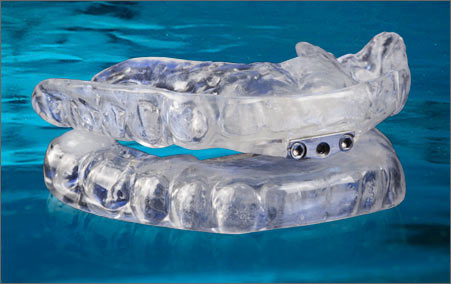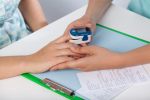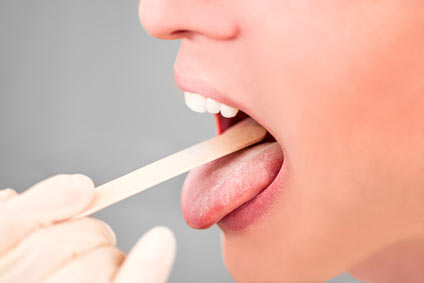Thornton Adjustable Positioner - The TAP Dental Device
TAP Dental Device for treating snoring and sleep apnea

© Glidewell Laboratories
Thornton adjustable positioner (TAP) is a special mandibular advancement device designed to improve obstructive sleep apnea and snoring, thereby improving health and quality of life.
The TAP appliance is:
- custom-made to prevent any change in teeth position or mouth structures,
- more comfortable than other mandibular advancement devices,
- adjustable by the patient at home, allowing maximum comfort and effectiveness.
The rate of efficiency for TAP device is so high, that it's considered one of the best CPAP alternatives.
How the Thornton Adjustable Positioner Works?
First of all, you need to know that TAP is effective only for patients with obstructive sleep apnea, when the airway completely collapses, blocking the airflow into the lungs.
The dental TAP appliance is preventing the airway to collapse, and it will maintain the airway open to allow air to pass through the throat.
The thornton adjustable positioner holds the lower jaw in a forward position so that is does not open during sleep and cause the airway to collapse. Keeping the mouth closed and the lower jaw in a forward position is the key to maintain the airway open.
By maintaining a clear airway, the TAP can improve breathing and reduce snoring during sleep.
How Effective is the Thornton Adjustable Positioner?
The clinical studies show significant improvements in patients with sleep apnea during the test and after the short or long-term evaluation:
The aim of this study was to compare the treatment efficiency of CPAP and the mandibular advancement device for long-term evaluation.21 patients were tested with dental devices and 22 patients with CPAP. The results were slightly better for CPAP; however, the CPAP patients showed more problems in accepting their treatment due to the CPAP side effects than the patients with oral devices.
This study demonstrates that the mandibular advancement devices, including the TAP appliance, may reduce the severity of obstructive sleep apnea for the entire period of the study (1 year).
How to Use the Thornton Adjustable Positioner?
This video demonstrates how to use the TAP 2 appliance for sleep apnea and snoring:
How to Clean the TAP?
Here is a good visual guide about how to properly clean a thornton adjustable positioner:
Thornton Adjustable Positioner Side Effects
The most common side effects with the use of TAP and other mandibular advancement devices are the following:
- excessive salivation - this is more prevalent at the beginning of the treatment and usually subsides with the continued use of the dental device.
- Face, muscle and temporomandibular joint (TMJ) discomfort - this problem usually occurs in the early stages of TAP therapy, but with continued use of the oral appliance the issue typically resolves over time.
If the salivation persists, then it may indicate that there is mouth breathing as a result of inadequate lip seal, or because the nasal airway is partially or totally blocked.
If you are a severe mouth breather, but your nasal airway is open, you can use a chin strap to help you keep the mouth closed.
The cause of the discomfort is associated with the strain on the masticatory musculature from moving the jaw forward for longer periods of time. However, you can easily prevent this issue with a range of mandibular motion exercises, using the therapeutic bite tab.
The bite tab is a small soft strip of plastic, a few millimeters thick, which can be easily improvised.
Important Exercises for Preventing Changes in Your Bite
Some good exercises to prevent long term changes in your bite from wearing a TAP dental device for sleep apnea can be found in this video:
- in the morning, after a night of using the TAP device, place a bite between your front teeth and slide your jaw forward. Then slide your jaw backwards, in the opposite direction as far as it will go and apply moderate biting pressure until you feel a slight tension up near your ear.
- Continue up to ten times repetitions, testing your bite recovery. Also, the short use of muscle relaxation medications, such as Flexeril, Skelaxin, or a similar medicine, may help when taken prior to initiating sleep.If the problem persists, is indicated to speak with the physical therapist.
- open the mouth as wide as possible. With the mouth held open, place the tongue up and as far back toward the soft palate as possible. Close the mouth while holding the tongue up in this position.
- Leaning your chin onto your palm at a table (or office desk) with head facing down, slack-jawed, can also be effective at restoring the bite. Repeat this process later in the day if needed.
- Some patients report limited gum chewing can be helpful.
- The mandibular advancement device may aggravate temporomandibular joint disease and may cause dental misalignment and discomfort that are unique to each device.
For other exercises to prevent the musculature discomfort please follow these steps:
This exercise is useful because it activates the muscles that retrude the mandible, thus counteracting the forces that advanced the mandible.
Sleep Apnea › Dental Devices › Thornton Adjustable Positioner







